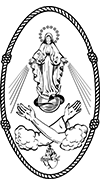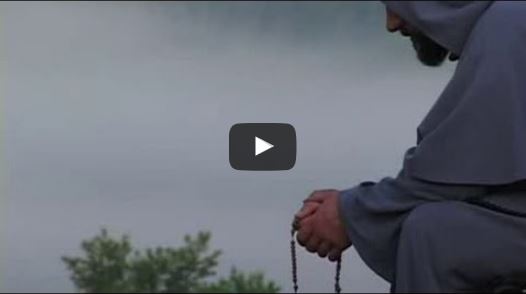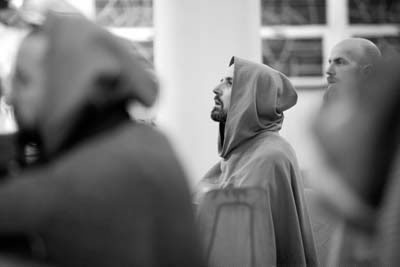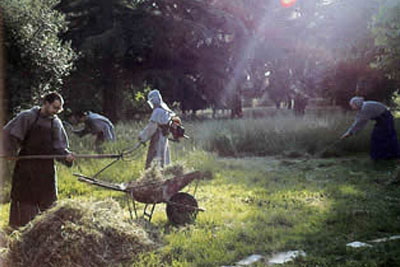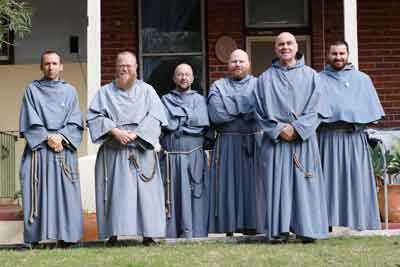FAQs
From Our Vocations DirectorHow many friars are there?
Currently, there are about 350 friars worldwide (in about 17 countries) including novices, but not including aspirants/postulants. In the U.S.A. there are about 40 friars in our 4 friaries (Griswold, CT, New Bedford, MA, Maine, NY, and Bloomington, IN).
How many postulants and novices are there in the U.S.?
The average number of candidates entering each year as aspirants/postulants is between 3 and 8, most of which continue their formation as novices.
What is the formation process?
The steps in the formation process are the following: about 1 year of aspirancy and postulancy, 1 year of novitiate, at the end of which is the first profession of vows, to be renewed annually for a total of 4 years, after which the friar may be admitted to perpetual profession of vows (sometimes referred to as “solemn vows”).
What about those discerning the call to the priesthood?
Those friars discerning the priesthood, and who have the recommendation and approval of the competent superiors, would begin their seminary formation soon after their first profession of vows, after being sent to a seminary in Italy (presently the Antonianum in Rome, run by the Order of Friars Minor) for 2 years of philosophy and 3 years of theology. If a friar-seminarian has already completed courses in philosophy, Church History, Latin, Greek, and/or theology, etc., they might not have to repeat those particular courses, depending upon the judgment of the seminary Rector. Those pursuing the priesthood must have entered (as an aspirant) at the age of 30 or younger, unless they have already received a bachelor’s degree from a college/university, in which case they must have entered (as an aspirant) at the age of 35 or younger.
How many friars become priests and how many are religious brothers?
On average, about half of our friars become priests, while the other half are religious brothers. Both are necessary in our religious family. Upon entering, aspirants-postulants may already desire to pursue the priesthood or the religious brotherhood, but in any case, the first years of formation provide ample time to discern the matter together with one’s spiritual director and formators.
How can your charism be described?
Our charism is to follow in the footsteps of St. Francis of Assisi, living according to the Definitive Rule of St. Francis (1223), after the example of St. Maximilian Mary Kolbe (sometimes known as the “St. Francis of the 20th century”), striving to achieve perfect union with Christ Crucified through the maternal mediation of the Immaculate Virgin Mary, and to conquer all souls for Christ through her, spreading devotion to her using any licit means (preaching, missions, mass-media, etc.). All of this is accomplished through our first, constitutive vow, called the “Marian Vow”, that is, unlimited consecration to the Immaculate Virgin Mary, which marianizes our whole religious life.
What’s your daily schedule or horarium like?
Here is the standard horarium, or daily schedule, for our friaries:
4:45 am – Rising.
5:00 – Prayer (Angleus, Community Vocal Prayers, Office of Readings, Morning Prayer, Mental Prayer for 1hr.).
7:00 – Holy Mass. Thanksgiving Prayers after Mass.
8:00 – Breakfast. Work (ministry, deskwork, manual work, apostolate, etc.).
1:00pm – Midday Prayer (Particular Examen, Spiritual Communion, Angelus).
1:15 – Lunch. Brief visit to the Blessed Sacrament. Dishes.
2:15 – Rest (optional).
3:30 – Prayer (spiritual reading, Rosary).
4:30 – Free time (study, prayer, recollection in one’s cell, necessary work, etc.).
7:00 – Holy Hour (Eucharistic exposition, Evening Prayer, Rosary, Benediction).
8:15 – Dinner (optional, except on Sundays and Solemnities).
8:45 – Prayer (Community Vocal Prayers, Compline). Discipline (except on Sundays, Solemnities and Feasts).
10:00 – Lights out.
What are your various ministries or apostolates?
Our ministries are principally: as far as the priestly ministry is concerned: providing the sacraments (Mass and Confession), spiritual direction; also: prayers/devotions/Eucharistic adoration in our chapels, periodic Marian processions/paraliturgies, giving talks/conferences to groups on spiritual themes, especially on Marian devotion and doctrine, foreign missions, forming the laity in our Marian cenacles (Mission of the Immaculate Mediatrix – M.I.M.) which meet monthly, evangelization through the mass-media (Internet, books, magazines, TV, film, radio, etc.), charitable works (assisting the poor, pro-life work, etc.). No matter what we do, we strive to do it for, through and in union with Our Lady, to make her more known and loved!
Are all of the FI friars called to be missionaries as well?
Ultimately, yes. By the very fact that the friars has emitted the Marian Vow of unlimited consecration to the Immaculate, he is, in effect, ready, willing and desirous to go wherever Our Lady wants and whenever she wants, and this is made known by means of obedience to one’s superiors. Practically speaking, however, a friar might not be sent to a foreign mission, perhaps for one or more of the following reasons: poor health, precarious situations with family members which would require his temporary presence or assistance, necessities in one’s own country or in another country (not considered to be mission territory), serious difficulties with a given language and/or culture, etc. But despite the apparent obstacles, the friars must still be “missionary-minded”, still ready and eager to go to the missions ad Gentes, especially those most difficult, and where dangers might be encountered, including a bloody martyrdom! For this, the friars should earnestly pray for!
Would an American friar be stationed in his own country, in the USA?
Normally, friars who are called to the priesthood go to our seminary in Italy (as stated above), while those not called to the priesthood, but to the brotherhood, would continue their formation and work in their own country or in another country which is part of the U.S. delegation (currently only Australia) or to another English-speaking country which is not part of the U.S. delegation (e.g. England, Nigeria, Philippines).
Upon ordination (for the friar-priest) or perpetual vows (for the religious brother), there are greater chances of being assigned to a foreign mission. Currently, however, there is need to stabilize each of our missions with native vocations, especially priests, so there have been more assignments of friars in their own countries. Ultimately, it depends on the needs of each mission, and the prudent decisions of the major superiors. The friars, for their part, know very well that the Marian Vow obliges them to be docile instruments in Our Lady’s hands, being her zealous missionaries, ready and willing to go anywhere at any time, solely to do God’s Will, her will, and to help save as many souls as possible.
What about the religious habit, and is it always worn?
Regarding the religious habit, we wear a blue-grey tunic with a hood, rope cord with four knots (representing our four vows: the Marian Vow of unlimited consecration to Our Lady, obedience, poverty and chastity), Miraculous Medal over the heart, sandles with bare feet (unless socks are deemed necessary, especially in cold regions/seasons). The habit is always worn. A nighttime habit (usually an older one) is also used. For heavy work, work habits are to be used.
Do the friars have any contact with family and friends?
Yes, and this is usually done by way of letters and phone calls, but also by personal visits to the friary every so often, and home visits during certain periods, if possible, especially at the end of postulancy, and after making first profession. Other periodic home visits are normally possible, especially in order to carry out some apostolate or for other serious reasons: for example, serious illness or death of a family member, wedding of a sibling, etc.
Could you give a summary of your formation procedure?
After preliminary contacts with the vocations director and one or more community of our friars (by phone, e-mail, visits) and being free of any impediments as well as displaying signs of a vocation, a candidate may be accepted as an aspirant, beginning the aspirancy during the summer (usually in early August), which lasts for a few months. In December (usually the 8th, Solemnity of the Immaculate Conception), the aspirant receives the postulant’s habit (tunic, cloth sash with Franciscan Crown//Rosary and Miraculous Medal over the heart) and begins the postulancy, lasting until the following September. During this first year (aspirancy and postulancy), the formation focuses on laying the foundations of a solid doctrinal and spiritual formation, with emphasis on our marian-franciscan charism. Normally, formation classes will be given about twice a week. Participation in the community acts (prayer, meals, recreation, apostolate, etc.) is the norm. Community life, in fact, is heavily stressed in our friaries, making evident the familial aspect of religious life.
After the postulancy begins the novitiate, which lasts at least one full year. During this year of formation, the novices are formed with greater intensity, with more attention given to understanding and living out the vows (Marian Vow of unlimited consecration to the Immaculate, obedience, poverty and chastity), fraternal-community life and apostolic-missionary life, and the virtues to be especially practiced by the religious. It is a year of testing the vocation as well, with special importance given to living out faithfully the virtue of obedience. Also, the Rule, Traccia (Marian Plan of Franciscan Life), Constitutions and Directory are thoroughly analyzed and explained. All this should enable the novice to approach the time of emitting his first vows with adequate preparation.
Upon making first vows, the newly-professed friar will either embrace the path to religious brotherhood or the path to the priesthood as a seminarian. (About half of our friars are religious brothers, the other half are priests.) Their formation will continue during the years of temporary vows (renewed annually for a total of 4 years) until they are able to emit their perpetual vows. Formation will be on-going, of course, so each community will see to it that there be a weekly spiritual conference for the whole community, if possible, with sufficient time to dedicate to personal study and reflectioin, making use of a well-equipped library in the friary, with special emphasis on an ever-deeper knowledge of mariology, franciscan philosophy and theology and the teachings of St. Maximilian Mary Kolbe.
How would you describe the average day in the friary?
In any one of our friaries throughout the world, there is a substantial unity in the life lived out in community, with obvious accidental differences among them, depending on factors such as nation, culture, number and composition of individual friars, etc. The current typical friary (what we would call a Marian Friary or Marian House
[vs. a Marian City, composed of at least 30 professed friars, which is something we hope to have one day]) is composed of about a handful of friars (3 to 7, for example). The atmosphere would better reflect that of a family, for, indeed, the community of friars is a religious, spiritual family.
The friary should first of all be a house of prayer. Prayer will animate the entire day, beginning at dusk (around 5am). Prayer in common will average about 4-5 hours per day, marking the key times of the day. More time will be spent in prayer during free-time, and then the countless occasions for those brief prayers, aspirations, or ejaculatory prayers. Prayer will be constant, therefore, and ever in union with Mary, the Virgin at Prayer.
After morning prayer and Holy Mass, the friars will then eat breakfast, in silence (while listening to an audio recording of a spiritual book or conference), unless there is a feast day or Sunday, which would have the friars converse with one another (recreation). Afterwards, they each help to clean the dishes and the refectory (dining room), either in silence or while praying the Most Holy Rosary or some other prayer together. Then follows the work period, involving some manual work, deskwork, house chores, apostolate or priestly ministry, lasting until midday prayer (with a brief particular examination of conscience, spiritual communion and the Angelus). (Sunday, of course, is a day of rest from the usual workload.)
Next is lunch, the main meal of the day. Usually there is recreation (conversation) at table. Afterwards, there is a brief visit to the Blessed Sacrament, and then the cleaning of the refectory and dishes, in silence or with the Rosary. Following is an optional rest period, or quiet time in one’s cell, the chapel, library, or perhaps an outdoor walk.
After the rest period is another block of time for prayer (about an hour), consisting of Spiritual Reading (personal reading of some spiritual book, especially the lives of the saints) and the Most Holy Rosary. Then follows some free time, to be spent in prayer, reflection and/or study (preferably in one’s cell), unless there is some urgent duty or work to attend to.
Later in the evening is the Holy Hour, consisting of Eucharistic exposition, Vespers, the Most Holy Rosary, Eucharistic and Marian visit (brief meditative readings), concluding with Eucharistic Benediction. An optional, light supper follows (with recreation).
The day concludes with night prayers, Compline, and the penitential practice of the discipline (for novices and professed friars). Lights out by about 10pm.
All in all, the average day in the friary is quite full, which is a great help in avoiding idleness, the “enemy of the soul” (Rule, Ch. 5). Such a structured day lived out in community is one of the great benefits of religious life, but it is also a great challenge, penance and sacrifice. Ultimately, it is the daily “white martyrdom”, that is, fidelity to the little things of everyday life in the friary, day after day, year after year, throughout one’s whole life, that constitutes the greatest sacrifice a friar can make, and for that reason the greatest proof of a truly authentic religious soul.
What about your liturgy? Do you have the Mass and Divine Office in Latin?
Ever since the Motu Proprio of Pope-emeritus Benedict XVI (which concerned the Traditional Latin Mass, or Tridentine Mass, referred to by the Pope as the Extraordinary Form of the Latin Rite
[EF]) in 2007, our Founder and (then) Minister General, Fr. Stefano Maria Manelli, personally began to celebrate the Mass according to the EF quite regularly, while at the same time continuing to celebrate the Novus Ordo (the Ordinary Form of the Latin Rite [OF]). He also encouraged all of our seminarians and priests to learn the EF and has permitted its celebration in our friaries according to the prudent judgment of local superiors.
Over the past few years, the EF has been frequently celebrated in our communities. Some friaries have celebrated the EF perhaps once or twice a week, while other friaries have celebrated it more often. Currently, as of August 2013, the Holy See has required our communities to celebrate only the OF as our Conventual Mass and any private Masses, at least temporarily, in order to work out any incorporation of the EF in our communities. However, permission to celebrate the EF has been granted by the Apostolic Commssioner (who is presently governing our Institute) to our communities where there is a pastoral need.
It is important to note that the celebration of the Mass according to the Novus Ordo in our friaries has always been and continues to be carried out with fidelity to the rubrics, with due reverence and respect. We also try to celebrate the OF in Latin, at times, or at least to include Latin for the various sung parts (Kyrie, Gloria, Credo, Agnus Dei, etc.), whenever possible.
Regarding the Divine Office, or Liturgy of the Hours, our friars throughout the world use the new breviary of Pope Paul VI. Here too, we try to incorporate some Latin, especially with hymns, repeated parts (like the Pater noster, Benedictus, Magnificat, Nunc dimittis, etc.), whenever possible. Normally, the Office is sung in plainchant (or “recto tono”), especially in smaller communities (e.g. 3-5 friars), but in some countries, some parts of the Office might be sung in different melodies (e.g. Gregorian psalm tones) on Feasts and Solemnities, whenever possible, especially in larger communities (such as houses of formation).
What’s the difference between the life of a friar and that of a monk?
Our daily lives are contemplative and active, that is, one of prayer and action, contemplation and the apostolate. Friars do not live exactly as monks, but differ from them in the following: in their mendicity, being mendicants/beggars (poverty), relying upon the charity of others to sustain them (food, necessary things for living, etc.), whereas monks usually are self-sustaining (by way of farming, production of some goods to sell and thereby have funds necessary to buy what is necessary to live, etc.); in their apostolate, which would make the friars more involved with the “world”, engaging in apostolic activity (preaching, giving talks/conferences, using the mass-media for evangelization, helping out in parishes [giving missions, etc.], or some deeds of mercy/assistance to the poor, etc), whereas monks normally do not have much contact with the world, living in greater solitude; in their missionary life, which requires the friars to be more available to be moved from one friary to another (perhaps once every few years or so), whereas monks remain in the same monastery all life long, unless there would be a new foundation, etc. (which is rare); in their smaller size of communities (for example, 4-8 friars in a friary), whereas in monasteries the community is usually much larger (for example, it’s quite normal to have 30-50 monks forming a community, perhaps more); in their liturgical prayer (Holy Mass and Liturgy of the Hours [Divine Office], which is usually more simple, and usually observing the 5 liturgical hours according to the new breviary of Paul VI (Office of Readings, Morning Prayer, Midday Prayer, Evening Prayer and Night Prayer), whereas monks observe the 8 liturgical hours (Matins, Lauds, Prime, Terce, Sext, None, Vespers, Compline), more prolonged (usually with more elaborate chants, like Gregorian Chant), this being their primary work (“opus Dei”, the work of God) together with manual labor to sustain the monastic community (the “Ora et labora” of St. Benedict, “Pray and work”). These are just a few examples of the differences of friars (especially Franciscan) and monks, generally speaking.
